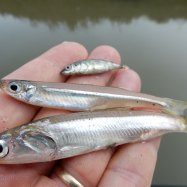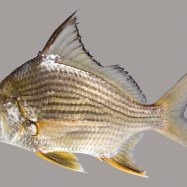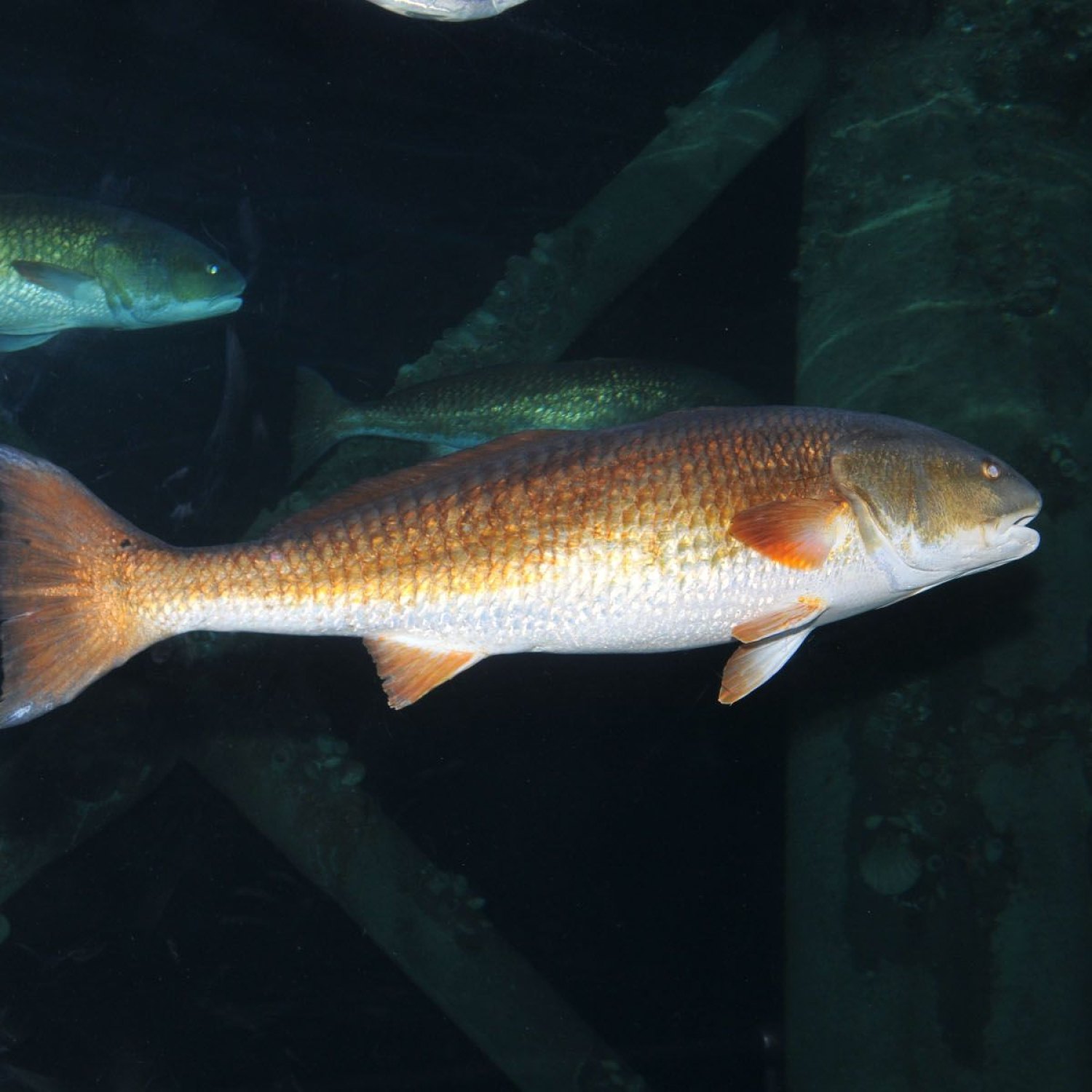
Red Drum Fish
Up to 5 feet
The Red Drum Fish, also known as Redfish, can grow up to 5 feet in length and can be found in the Gulf of Mexico and Southeast Atlantic coast. It belongs to the Sciaenidae family and has an elongated and laterally compressed body shape. These beautiful fish are popular among anglers due to their fighting ability and delicious taste. #RedDrumFish #Fishing #GulfofMexico #SoutheastAtlantic #Sciaenidae
Animal Details Summary:
Common Name: Red Drum Fish
Kingdom: Animalia
Habitat: Coastal waters
The Fascinating Red Drum Fish: A Colorful and Mighty Predator of the Western Atlantic Ocean
The ocean is a vast and mysterious world, teeming with a diverse array of creatures. Among them, there is one fish that stands out with its distinct coloring and impressive size - the Red Drum Fish. Scientifically known as Sciaenops ocellatus, this powerful predator is commonly referred to as the Red Drum due to its reddish-bronze or copper colored skin. It is a member of the Sciaenidae family and can be found in the coastal waters of the Western Atlantic Ocean, particularly in the Gulf of Mexico and the Southeast Atlantic coast Red Drum Fish.Many enthusiasts and avid anglers consider the Red Drum Fish to be a prized catch. Its remarkable ability to put up a fight and the impressive size it can reach make it a popular game fish. But aside from its sporting value, the Red Drum is also a fascinating and important species that plays a crucial role in the ocean ecosystem. In this article, we will delve deeper into the world of the Red Drum Fish - its characteristics, habitat, behavior, and the impact it has on the marine environment.
The Anatomy of the Red Drum Fish
Like all animals, the Red Drum Fish belongs to a kingdom, phylum, class, order, and family. In this case, it belongs to the Animalia kingdom, Chordata phylum, Actinopterygii class, Perciformes order, and Sciaenidae family. Its name, Sciaenops ocellatus, comes from the Greek words “skia” meaning shade or shadow and “ops” meaning eye, referring to the dark spot found near its tail.The Red Drum can grow up to 5 feet in length and can weigh as much as 90 pounds, making it one of the largest game fish in the Atlantic. Its body is characterized by an elongated and laterally compressed shape, allowing it to swim quickly and efficiently Ragdoll. Its eyes are located on the top of its head, giving it an almost flattened appearance, and its mouth is positioned slightly downward, making it easy to catch prey swimming in the water column.
When it comes to coloration, the Red Drum has a unique combination of colors, making it easily distinguishable from other fish. Its body is covered in a bronze or copper-colored skin with a silvery-white underside. The most prominent feature, however, is its dark tail, which is where it gets the “drum” part of its name. This dark tail serves as a camouflage, helping the fish blend in with its surroundings and avoid potential predators.
A Mighty Predator with a Carnivorous Diet
As mentioned earlier, the Red Drum Fish is a formidable and powerful predator, thanks to its impressive size and strength. And with its well-adapted body and keen senses, it is well-equipped to hunt for its food in the ocean. The Red Drum is a carnivorous fish, which means it feeds on other animals, particularly smaller fish, crustaceans, and mollusks.Due to its sharp teeth and strong jaws, the Red Drum is capable of crushing and grinding shells, making it a versatile hunter that can consume a wide variety of prey. It typically feeds during the early morning and evening when the water is calmer and prey is abundant. Its keen eyesight and lateral line system, which allows it to detect vibrations in the water, also play a significant role in its hunting success.
The Habitat and Distribution of the Red Drum Fish
Red Drum Fish are primarily found in the western Atlantic Ocean, from as far north as Massachusetts to as far south as Florida, and as far west as Texas. However, they are most abundant in the Gulf of Mexico and the Southeast Atlantic coast, particularly in the states of Louisiana, Florida, and North Carolina.As coastal fish, the Red Drum prefers shallow waters, particularly marshy or muddy areas with seagrass or oyster beds. These habitats provide the perfect cover for the fish, protecting them from potential predators and allowing them to hunt for their prey. Additionally, the Red Drum can also be found in estuaries, where rivers meet the ocean, because the brackish water provides them with ample food supply and protection.
The Importance of the Red Drum Fish in the Ecosystem
The Red Drum Fish plays a vital role in the ocean ecosystem. As predators, they contribute to regulating the population of their prey, ensuring that one species does not become too abundant and upset the delicate balance of the ecosystem. Their consumption of crustaceans and mollusks also helps maintain the health of the seagrass beds and oyster reefs, which serve as essential habitats for many other marine creatures.Moreover, the Red Drum also serves as a valuable protein source for humans. Commercial and recreational fishing for Red Drum is a significant industry in the United States, with regulations in place to ensure sustainability. However, the population of this species is still vulnerable to overfishing, making it crucial for us to protect and conserve their habitat to maintain a healthy population.
Conservation Efforts for the Red Drum Fish
The Red Drum Fish is currently not listed as an endangered species, with its population being relatively stable. However, it is still vital to take measures to protect and conserve this species, especially with the increased threats to their habitat and overfishing.In the Gulf of Mexico, the Red Drum Fish is managed as a single stock, which means that all individuals are considered part of the same population regardless of their location. This allows for more effective management and monitoring of the species. Additionally, there are size and bag limits in place for recreational fishing, and commercial fishing for Red Drum is regulated by the National Oceanic and Atmospheric Administration (NOAA).
Other efforts to conserve this species include the restoration of seagrass and oyster beds, which provide essential habitats for the Red Drum, as well as implementing catch-and-release practices for recreational anglers to minimize the impact on the population.
In Conclusion
The Red Drum Fish is a unique and impressive species that plays a crucial role in the Western Atlantic Ocean ecosystem. Its striking appearance, remarkable hunting abilities, and important ecological role make it a fascinating subject to study and admire. However, with the increasing threats to their habitat and population, it is our responsibility to protect and conserve this magnificent and mighty predator, ensuring it continues to thrive in the ocean for generations to come.

Red Drum Fish
Animal Details Red Drum Fish - Scientific Name: Sciaenops ocellatus
- Category: Animals R
- Scientific Name: Sciaenops ocellatus
- Common Name: Red Drum Fish
- Kingdom: Animalia
- Phylum: Chordata
- Class: Actinopterygii
- Order: Perciformes
- Family: Sciaenidae
- Habitat: Coastal waters
- Feeding Method: Carnivorous
- Geographical Distribution: Western Atlantic Ocean
- Country of Origin: United States
- Location: Gulf of Mexico and Southeast Atlantic coast
- Animal Coloration: Bronze or copper-colored with a dark tail
- Body Shape: Elongated and laterally compressed
- Length: Up to 5 feet
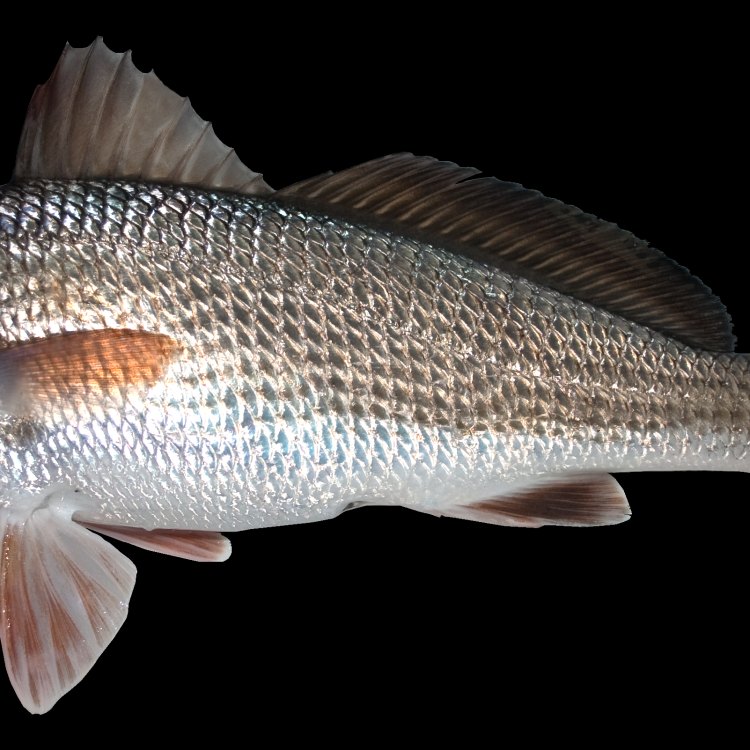
Red Drum Fish
- Adult Size: 20-30 inches
- Average Lifespan: 10-20 years
- Reproduction: Sexual
- Reproductive Behavior: Spawning in nearshore waters
- Sound or Call: Produce drumming sounds with their swim bladder
- Migration Pattern: Migrate inshore to spawn
- Social Groups: Solitary or in small groups
- Behavior: Bottom-dwelling and active predators
- Threats: Overfishing and habitat loss
- Conservation Status: Near Threatened
- Impact on Ecosystem: Important predators and prey in coastal ecosystems
- Human Use: Popular game fish and aquaculture species
- Distinctive Features: Large scales and dark tail spot
- Interesting Facts: Red drum fish can produce low-frequency drumming sounds, hence the name 'drum'
- Predator: Sharks and larger predatory fish
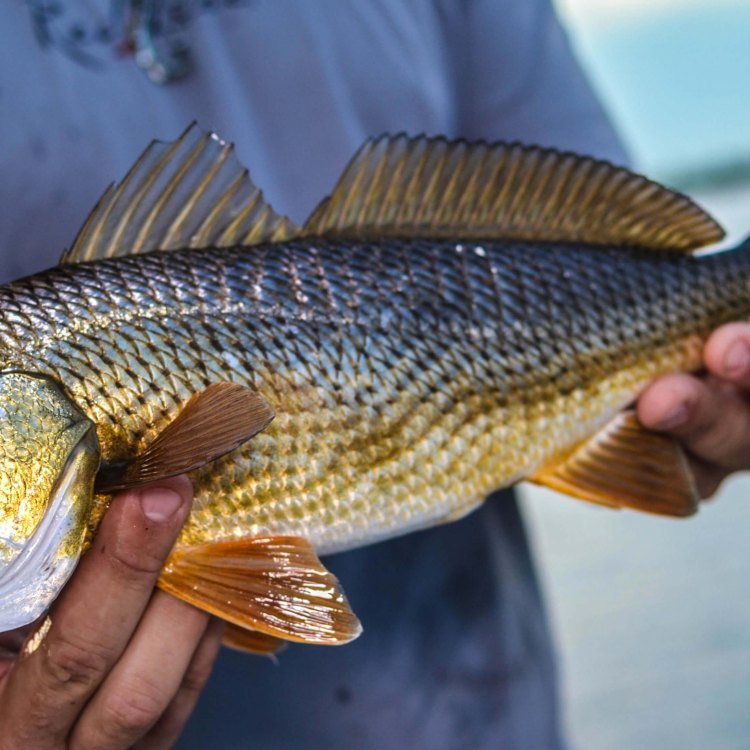
Sciaenops ocellatus
The Fascinating Red Drum Fish: An Icon of Coastal Ecosystems
From the waters of the Gulf of Mexico to the Atlantic coast, the red drum fish stands out as one of the most iconic species of inshore fish. With its vibrant red color and unique features, this fish has captured the attention of fishermen, biologists, and food enthusiasts alike. But there is more to the red drum fish than meets the eye. In this article, we will delve deep into the fascinating world of this species, from its behavior and biology to its ecological importance and human use PeaceOfAnimals.Com.Adult red drum fish can reach an impressive size of 20-30 inches, making it one of the largest inshore fish species. They have an average lifespan of 10-20 years, although some individuals have been recorded to live up to 40 years. These long-living fish undergo sexual reproduction, where females release eggs and males fertilize them externally. But what makes the red drum fish truly unique is their reproductive behavior.
The red drum fish spawn in nearshore waters, close to the coast. During the spawning season, which typically occurs from August to October, large numbers of fish migrate inshore to spawn. This behavior is known as anadromous, where fish migrate from the sea to freshwater to reproduce. This behavior also makes red drum fish vulnerable to overfishing, as they can be easily targeted in their spawning grounds. Human activities such as dredging and pollution can also disrupt their migration patterns, affecting their reproductive success Roe Deer.
One of the most distinctive features of red drum fish is their ability to produce drumming sounds. This is achieved by using their swim bladder, a gas-filled organ that helps them maintain buoyancy. They produce drumming sounds by contracting the muscles around the swim bladder, creating a low-frequency thumping sound. This ability is where they get the name "drum fish" from. While the exact purpose of these sounds is still unclear, scientists believe that they may use it for communication, attracting mates, or scaring off predators.
Aside from their reproductive behavior and unique drumming abilities, the red drum fish also plays a crucial role in coastal ecosystems. As bottom-dwelling and active predators, they prey on small crustaceans, fish, and mollusks, keeping their populations in check. At the same time, they also serve as an important food source for larger predatory fish, such as sharks and tuna. This makes them a vital part of the food chain in coastal ecosystems, contributing to their balance and health.
However, the red drum fish faces threats that put its population at risk. Overfishing, in particular, has been a significant concern for this species. As mentioned earlier, their migration behavior makes them more vulnerable to being caught in large numbers, leading to a decline in their population. Furthermore, habitat loss, pollution, and climate change can also impact their survival. These factors have resulted in the red drum fish being classified as 'near threatened' on the IUCN Red List of Threatened Species.
But despite the threats they face, red drum fish continue to thrive in coastal waters. Their resilience and adaptability have made them popular game fish, attracting anglers from all over the world. They are known for their strong fighting abilities, making them a challenging catch for experienced fishermen. In addition, their delicious white flesh and mild flavor make them a prized food fish. As a result, they are also a popular species for aquaculture, where they are farmed for commercial purposes.
Besides their importance in fishing and aquaculture, the red drum fish also has a role in human culture and folklore. In Southern states such as Louisiana and Texas, red drum fish are often referred to as "redfish" and are deeply ingrained in the local cuisine and traditions. They are also a popular subject in art and literature, with many artists using their striking red color as inspiration for their work.
Red drum fish possess several distinctive features that set them apart from other fish species. Their large scales and dark tail spot are among their most prominent characteristics, helping them blend in with their surroundings and providing camouflage from predators. This dark spot is also known as an "eyespot" and is thought to confuse predators by diverting their attention away from the fish's vital organs.
As we've learned, the red drum fish is a unique and fascinating species with many ecological and cultural significance. From their reproductive behavior and drumming sounds to their predators and human use, these fish have captured our attention for centuries. But it is crucial to understand and protect these fish, as they play a vital role in maintaining the balance and health of coastal ecosystems.
In conclusion, the red drum fish is a true icon of coastal ecosystems, with its striking red color, interesting behavior, and diverse uses. The challenges they face require proper management and conservation efforts to ensure their survival in the wild. Whether you are a fisherman, conservationist, or simply an admirer of nature, the red drum fish is a species worth learning more about. Its story is a testament to the delicate balance of our planet's ecosystems and the importance of preserving them for future generations to come.
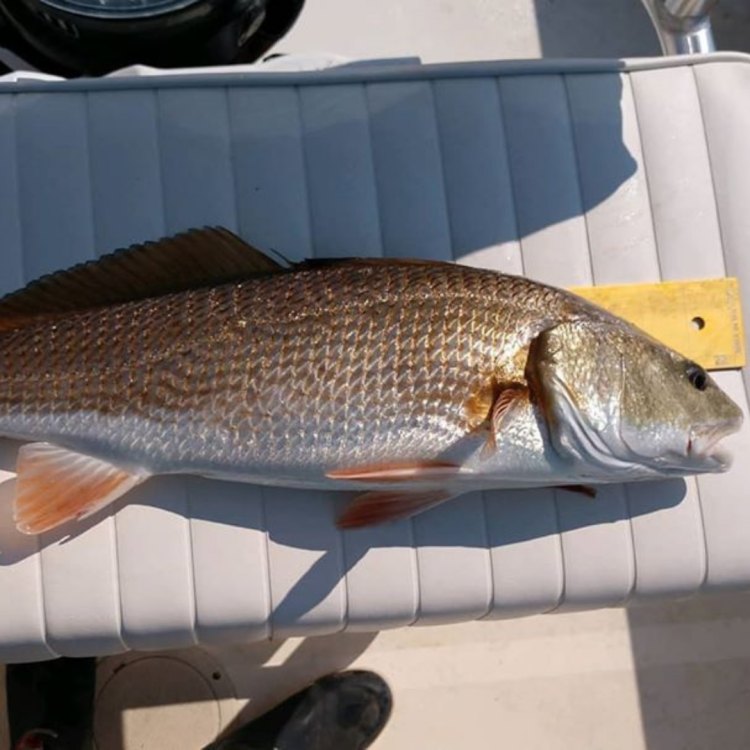
The Fascinating Red Drum Fish: A Colorful and Mighty Predator of the Western Atlantic Ocean
Disclaimer: The content provided is for informational purposes only. We cannot guarantee the accuracy of the information on this page 100%. All information provided here may change without prior notice.



